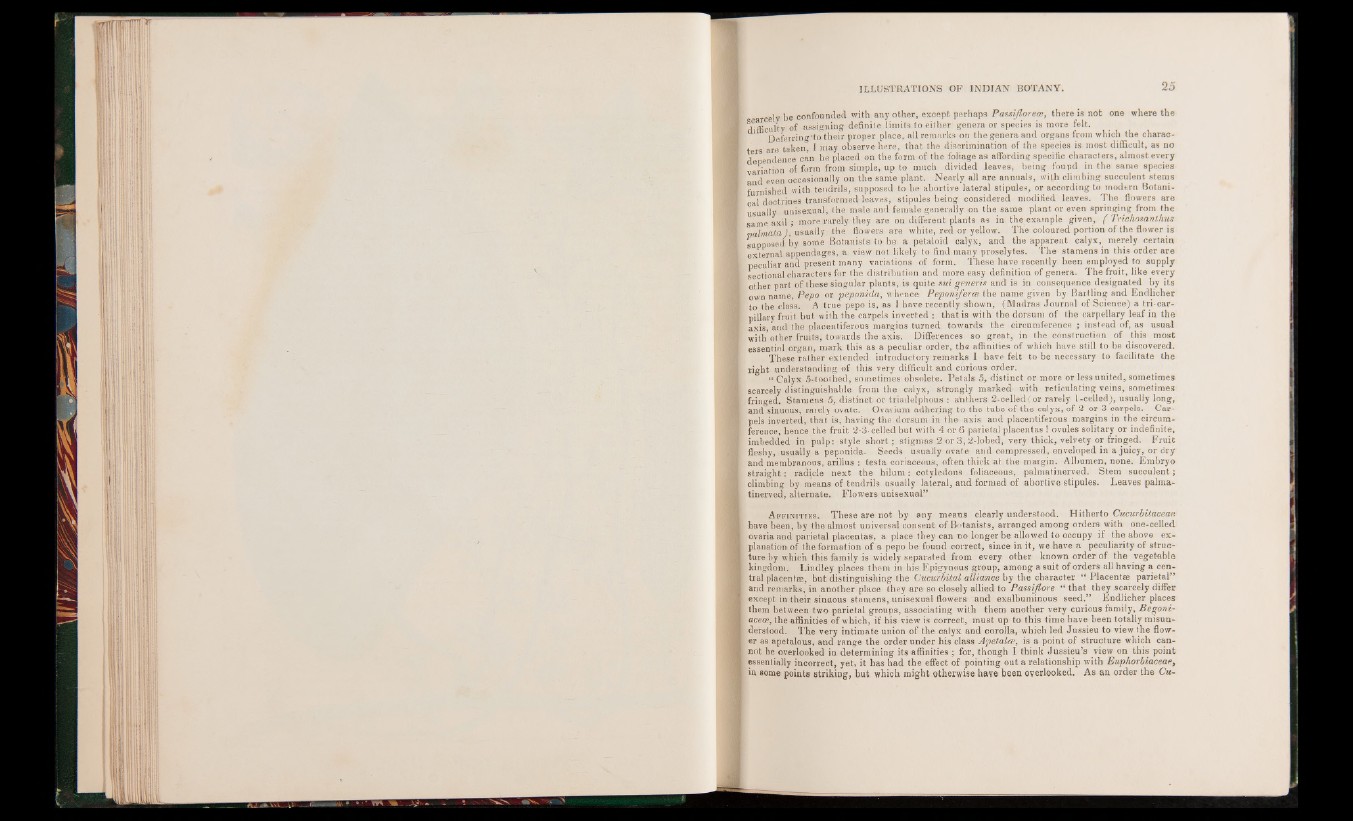
rcelv be confounded with any other, except perhaps Passiflorece, there is not one where the
difficulty of assigning definite limits to either genera or species is more felt.
01 Deferring*to their proper place, all remarks on the genera and organs from which the charac-
, are taken, I may observe here, that the discrimination of the species is most difficult, as no
d^Dendence can be placed on the form of the foliage as affording specific characters, almost every
variation of form from simple, up to much divided leaves, being found in the same species
and even occasionally on the same plant. Nearly all are annuals, with climbing succulent stems
furnished with tendrils, supposed to be abortive lateral stipules, or according to modern Botanical
doctrines transformed leaves, stipules being considered modified leaves. The flowers are
usually unisexual, the male and female generally on the same plant or even springing from the
same axil ; more rarely they are on different plants as in the example given, ( Trichosanthus
n a lm a ta% usually the flowers are white, red or yellow. The coloured portion of the flower is
supposed by some Botanists to be a petaloid calyx, and the apparent calyx, merely certain
external appendages, a view not likely to find many proselytes. The stamens in this order are
peculiar and present many variations of form. These have recently been employed to supply
sectional characters for the distribution and more easy definition of genera. The fruit, like every
other part of these singular plants, is quite sui generis and is in consequence designated by its
own name, Pepo or peponida, whence Peponifercs the name given by Bar fling and Endlicher
to the class. A true pepo is, as I have recently shown, (Madras Journal of Science) a tri-car-
pillary fruit but with the carpels inverted : that is with the dorsum of the carpellary leaf in the
axis and the placentiferous margins turned towards the circumference ; instead of, as usual
with other fruits, towards the axis. Differences so great, in the construction of this most
essential organ, mark this as a peculiar order, the affinities of which have still to be discovered.
These rather extended introductory remarks I have felt to be necessary to facilitate the
right understanding of this very difficult and curious order.
“ Calyx .5-toothed, sometimes obsolete. Petals 5, distinct or more or less united, sometimes
scarcely distinguishable from the calyx, strongly marked with reticulating veins, sometimes
fringed. St.amens-5, distinct or triadelphous : anthers 2-celled (or rarely l-celled), usually long,
and sinuous, rarely ovate. Ovarium adhering to the tube of the calyx, of 2 or 3 carpels. Carpels
inverted, that is, having the dorsum in the axis and placentiferous margins in the circumference,
hence the fruit 2-3-celled but with 4 or 6 parietal placentas ! ovules solitary or indefinite,
imbedded in pulp: style short; stigmas 2 or 3, 2-lobed, very thick, velvety or fringed. Fruit
fleshy, usually a peponida. Seeds usually ovate and compressed, enveloped in a juicy, or dry
and membranous, arillus : testa coriaceous, often thick at the margin. Albumen, none. Embryo
straight: radicle next the hilum: cotyledons foliaceous, palmatinerved. Stem succulent;
climbing by means of tendrils usually lateral, and formed of abortive stipules. Leaves palmatinerved,
alternate. Flowers unisexual”
A f f in it ie s. These are not by any means clearly understood. Hitherto Cucurbitaceae
have been, by the almost universal consent of Botanists, arranged among orders with one-celled
ovaria and parietal placentas, a place they can no longer be allowed to occupy if the above explanation
of the formation of a pepo be found correct, since in it, we have a peculiarity of structure
by which this family is widely separated from every other known order of the vegetable
kingdom. Lindley places them in his Epigynous group, among a suit of orders all having a central
placentse, but distinguishing the Cucurbital alliance by the character “ Placentae parietal”
and remarks, in another place they are so closely allied to Passi/lore “ that they scarcely differ
except in their sinuous stamens, unisexual flowers and exalbuminous seed.” Endlicher places
them between two parietal groups, associating with them another very curious family, Begoni-
acece, the affinities of which, if his view is correct, must up to this time have been totally misunderstood.
The very intimate union of the calyx and corolla, which led Jussieu to view the flower
as apetalous, and range the order under his class Apetalce, is a point of structure which cannot
be overlooked in determining its affinities ; for, though I think Jussieu’s view on this point
essentially incorrect, yet, it has had the effect of pointing out a relationship with Euphorbiaceaey
in some points striking, but which might otherwise have been overlooked. As an order the Cu~